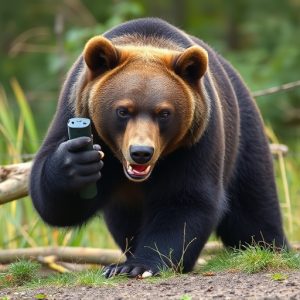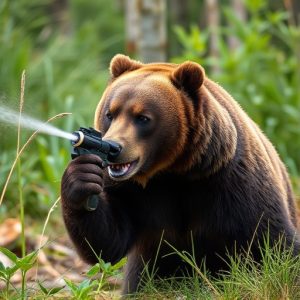Bear Protection: Using Bear Spray & Safety Tips for Aggressive Bears
Understanding bear behavior and utilizing bear spray effectively are key to outdoor safety in areas…….
Understanding bear behavior and utilizing bear spray effectively are key to outdoor safety in areas with high bear activity. Bears have a powerful sense of smell, amplified by wind direction, which aids in locating food sources. To maximize bear spray's effectiveness, aim against the wind while maintaining calmness, making loud noises, and slowly backing away if encountered. Safety tips include regular training, quick decision-making, staying alert, avoiding unexpected encounters, and securing food properly to deter aggressive bears.
In many outdoor spaces, especially in regions shared with aggressive bears, understanding and prioritizing safety is paramount. This comprehensive guide delves into effective strategies for navigating encounters with these powerful creatures. From deciphering bear behavior and their remarkable sense of smell to the crucial role of bear spray and essential safety tips, we equip you with knowledge to foster peaceful coexistence. Remember, awareness and preparation are key when venturing outdoors in areas inhabited by bears, and understanding the wind direction can significantly enhance your safety.
- Understanding Bear Behavior and Their Sense of Smell
- The Role of Bear Spray in Deterring Aggressive Bears
- Essential Safety Tips for Navigating Outdoor Spaces with Bears
Understanding Bear Behavior and Their Sense of Smell
Understanding bear behavior is a critical component of outdoor safety, especially in areas where bears are prevalent. Knowing their habits and sensory capabilities can significantly enhance your chances of avoiding dangerous encounters. Bears have an exceptional sense of smell, up to 200 times more sensitive than humans. This ability allows them to detect food sources from considerable distances, which is why it’s essential to store food securely when camping or hiking in bear country.
The wind direction plays a vital role in how bears perceive their surroundings. They primarily rely on scent to navigate and hunt, so the wind can carry your presence (and food) towards them unnoticed. When using bear spray as a deterrent, consider the wind direction. Aim for upward and slightly backward angles to ensure the spray reaches the bear effectively. Safety tips include staying calm, making loud noises, and backing away slowly if you spot a bear; these actions often discourage bears from approaching further.
The Role of Bear Spray in Deterring Aggressive Bears
Bear spray is a powerful tool for deterring aggressive bears and ensuring your safety in wild environments. When faced with an encounter, understanding the wind direction becomes crucial. Aiming bear spray directly at the bear, while considering the wind’s position, can significantly increase its effectiveness. The spray creates a barrier of irritants that can temporarily disable the bear, giving you valuable time to retreat or defend yourself.
It’s essential to follow safety tips when carrying bear spray. Always keep it readily accessible and ensure proper training on usage. Practice making quick decisions in case of an encounter, as every second counts. By combining knowledge of wind direction with regular practice, individuals can enhance their ability to protect themselves against aggressive bears in outdoor settings.
Essential Safety Tips for Navigating Outdoor Spaces with Bears
When venturing into bear country, prioritizing safety is non-negotiable. One of the most effective tools in your arsenal against aggressive bears is bear spray. This powerful deterrent should be carried prominently and used according to instructions when encountering a bear. Understanding the wind direction is crucial; always ensure you’re spraying towards the bear, as the active ingredients can travel back onto you if the breeze shifts.
Safety tips extend beyond just carrying bear spray. Making noise while hiking can help deter bears, so speak loudly or sing. Staying aware of your surroundings and avoiding unexpected encounters is key. Bears are typically cautious and will avoid humans. Never approach a bear cub, as mother bears are extremely protective; instead, give them space and a clear escape route. Remember to store food securely in bear-resistant containers, keeping your camping area clean and free from attractants like garbage or pet food.
Understanding bear behavior and utilizing effective deterrents like bear spray, along with adhering to essential safety tips, are key strategies in navigating outdoor spaces shared with aggressive bears. By being aware of local conditions, including wind direction, and following guidelines strictly, you can significantly reduce risks. Remember, a proactive approach combining knowledge and the proper tools, such as bear spray, is crucial for a safe and enjoyable outdoors experience.


